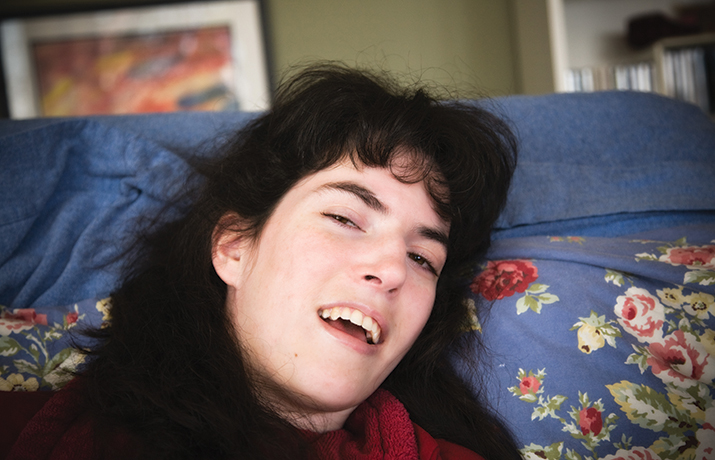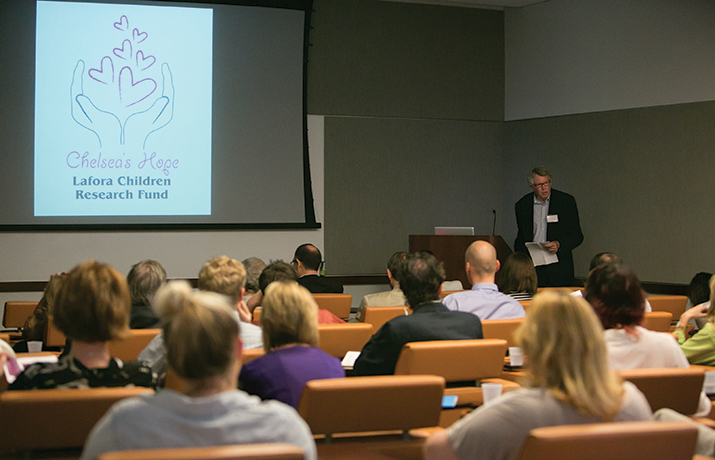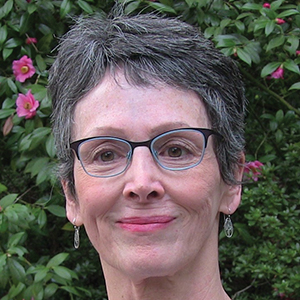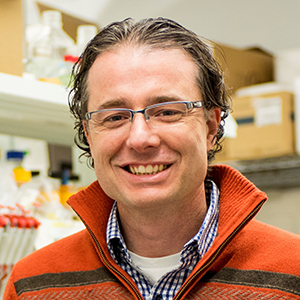Passionate parents catalyze research
In 2007, at the University of California, San Diego, School of Medicine’s white coat ceremony for entering medical students, a young man and woman met. Jesse Dixon is the son of Jack Dixon, a prominent biochemist who studied a rare condition called Lafora disease. Katie Rice had a younger sister, Kristen, who suffered from the disease. Little did the two aspiring physicians know when they first laid eyes on one another at that ceremony that soon their futures would intertwine in a manner that would have a profound effect not only on their own lives but on those of Lafora patients around the world.
The story of the research into Lafora disease highlights the importance of both human connections and defining the basic biochemistry of a disease. We are part of the story:
Matthew Gentry performed fundamental research into the disease while he was a postdoctoral fellow in Jack Dixon’s lab at UCSD. (Dixon is a former president of the American Society for Biochemistry and Molecular Biology.) Gentry’s lab continues to work on LD at the University of Kentucky. The human connections were facilitated by Kim Rice (Katie’s mother) and Jack Dixon.
LD is an autosomal recessive neurodegenerative epilepsy that is fatal. Its onset is in adolescence in apparently healthy teenagers, who begin to suffer headaches, seizures that look like bouts of staring, and visual auras. Patients then typically experience generalized seizures and insidious decline in cognitive function.
LD initially is difficult to distinguish from other juvenile epilepsies. But as time goes on, LD patients also develop highly frightening epileptic and nonepileptic visual hallucinations.
The initial response LD patients have to antiepileptic drugs is lost within three years, and constant bouts of myoclonic epilepsy begin. The patients then develop dementia, often disinhibited, and seizures with increased frequency despite any number or combination of antiepileptic drugs. The patients become bedridden. Death comes after a protracted decade of unceasing epilepsy in the form of a particularly massive seizure or pneumonia.
 Kristen Rice suffered from Lafora disease. PHOTOS COURTESY OF CHERYL BIGMAN
Kristen Rice suffered from Lafora disease. PHOTOS COURTESY OF CHERYL BIGMAN
Biochemistry reveals mechanism
LD first was described in 1911 by Gonzalo Rodriquez–Lafora. Lafora described results from an 18-year-old patient. Among other things, Lafora noted in the paper he published in the journal Virchows Archiv “amyloid bodies in the protoplasm of the ganglion cells.”
Amyloid originally referred to substances that stained in a manner similar to starch rather than the protein inclusions now associated with Alzheimer’s disease. These deposits that Lafora described in LD patients were later shown to be inclusions comprised of water-insoluble glucose chains more similar to plant starch than human glycogen. The deposits are named Lafora bodies. More than 100 years later, Joan Guinovart’s lab at the Institute for Research in Biomedicine Barcelona demonstrated that LBs are the pathogenic cause of LD.
LD research was revolutionized in 1995 when Jose Serratosa and Antonio Delgado–Escueta at the University of California, Los Angeles, located the first chromosome locus for LD. Subsequent papers described the discovery of the EPM2A gene, which was led by Berge Minassian at University of Toronto and the Hospital for Sick Children Research Institute and by Jose Serratosa at the Laboratory of Neurology Jimenez Diaz Foundation in Spain. Mutations in EPM2A account for about 50 percent of LD cases. Subsequently, Minassian, Delgado–Escueta and colleagues identified the EPM2B/NHLRC1 gene as the second LD locus in 2003.
Once the affected genes were known, the focus turned to defining the function of the protein product of each gene. In Dixon’s lab at UCSD, Gentry and Carolyn Worby demonstrated that malin, encoded by EPM2B, is an E3 ubiquitin ligase that ubiquitinates proteins involved in glycogen metabolism. They also showed that laforin, encoded by EPM2A, is not a protein phosphatase but that it dephosphorylates carbohydrates. They proposed that loss of laforin results in hyperphosphorylated glycogen that disrupts branching and leads to longer glucose chains that develop into LBs.
This hypothesis was corroborated by the labs of Peter Roach and Anna Depaoli–Roach at Indiana University and Minassian using LD mouse models to show that LD mice developed LBs, that these LBs were hyperphosphorylated, that the glycogen branching was aberrant, and that recombinant laforin could remove the phosphate. Subsequently, the Roach, Depaoli–Roach and Minassian laboratories demonstrated that reducing glycogen synthesis by 50 percent abolished LD in mouse models.
Determined parents
Katie and Jesse began to date as first-year medical classmates in 2007. Their relationship progressed, and they decided that it was time to introduce one another to their parents. By this time, the strange coincidence had surfaced that Katie’s sister suffered from the same rare disease that was of paramount interest to researchers in Jesse’s father’s lab.
It was not until the families actually met that the implications for Lafora research would begin to emerge. Jack Dixon had studied the disease for many years, but Katie’s sister Kristen was the first patient he ever had met. Seeing the ravages of the disease firsthand drove home the potential of his research to impact lives profoundly.
Along with Katie’s father, Jim Rice, Jack began to think outside the box about steps that could be taken to accelerate progress in Lafora research. They came up with the idea of an international workshop. Katie’s mother, Kim Rice, a member of the board of directors of Chelsea’s Hope, the North American Lafora advocacy group, took responsibility for fundraising and organizing the event. Kim worked closely with Linda Gerber, the founder of Chelsea’s Hope and mother of an LD patient, to coordinate the event. Jack agreed to invite each of the scientists personally and to host the workshop. Under the sponsorship of Chelsea’s Hope, it all came together as the 1st International Lafora Workshop in June 2014 at the Sanford Consortium for Regenerative Medicine in La Jolla, California.
 Chelsea Gerber, for whom the foundation Chelsea’s Hope is named, suffered from Lafora disease.
Chelsea Gerber, for whom the foundation Chelsea’s Hope is named, suffered from Lafora disease.
Scientific momentum
The workshop allowed each research group to present its latest findings. All were in agreement that the identification of the genetic basis for LD had ushered in a new era in understanding the cause, leading to rapid progress in the field and opening up the possibility of a cure. Collectively, data from the laboratories presented at the workshop definitively demonstrated that eliminating LBs and reversal of this starchlike accumulation wholly abolished LD in mouse models. Thus, we and other researchers found ourselves positioned to realize the dream of treating and curing LD patients.
During the workshop discussions, the idea nucleated to write a collaborative U54 center grant to request funding from the National Institutes of Health. The grant had three main foci: 1) personalizing diagnosis of LD patient mutations at the biochemical and atomic levels, 2) establishing methods to inhibit glycogen synthesis, and 3) defining the window of opportunity when LB progression could be stopped and reversed.
While the group was excited about these goals immediately, the deadline for the grant was just four months away. Reality started to settle in. The group members felt they likely could not put together a successful large mechanism grant in such a short time. Jim Rice, Katie and Kristen’s father, stood up from the back of the room and stated, “I’m going to play the parent card and ask that you guys pull together and get this done.”
The group could not resist his plea. The members of the group wrote a U54 grant that received the best score, but the NIH did not fund any U54 grants in that cycle. The group was disappointed but not defeated. They split the clinical component of the grant away from the basic and translational portion, wrote a grant focusing on the basic and translational components, and subsequently obtained a P01 program project grant entitled “Lafora epilepsy: basic mechanisms to therapies” that established the Lafora Epilepsy Cure Initiative. They now are applying for funding for the clinical aspects so that the patient cohort is available when therapies are ready.
The LECI P01 is a unique collaboration between labs that once were competitors. It comprises four scientific projects and three core facilities. Members of the collaboration include Gentry at the University of Kentucky as the P01 director along with Craig Vander Kooi, Sylvie Garneau–Tsodokova and Dave Watt; Peter Roach, Anna DePaoli–Roach, Tom Hurley and Steve Johnson (Indiana University); Carolyn Worby (UCSD); Pascual Sanz (Institute of Biomedicine, Valencia); Gino Cingolani (Thomas Jefferson University); Guinovart; Minassian and Serratosa. Jack Dixon and Antonio Delgado–Escueta have provided invaluable advice and direction throughout the process.
 Biochemist Jack Dixon gives a talk at the Lafora disease meeting.
Biochemist Jack Dixon gives a talk at the Lafora disease meeting.
A blueprint
The story of LD provides an excellent blueprint for how to attack a genetically inherited disease through basic research: identify the genes, generate mouse models, define the function of the proteins, and target specific biochemical pathways to alleviate or ablate disease outcomes. Yet without the personal interactions, it is extremely unlikely that clinical trials now would be on the horizon.
The group is pleased with recent successes but is not satisfied. Real work lies ahead: It is a unique opportunity to demonstrate how basic research combined with personal interactions can be translated into therapies and a cure.
The group has made dramatic progress over the past decade, but the hoped-for cure will not come soon enough for many. Kristen Rice and Chelsea Gerber both succumbed to the disease. Kristen died in 2014. Chelsea died in December. But their deaths have not in any way lessened the hope that is growing stronger every day as researchers get ever closer to their goal of curing the disease.
Katie and Jesse are now married. Katie practices ob-gyn in San Diego, and Jesse runs his laboratory at the Salk Institute. They have two children: Kristen (named after Katie’s sister) and Jack (named after Jesse’s dad).
Enjoy reading ASBMB Today?
Become a member to receive the print edition four times a year and the digital edition monthly.
Learn moreGet the latest from ASBMB Today
Enter your email address, and we’ll send you a weekly email with recent articles, interviews and more.
Latest in Science
Science highlights or most popular articles

Mining microbes for rare earth solutions
Joseph Cotruvo, Jr., will receive the ASBMB Mildred Cohn Young Investigator Award at the ASBMB Annual Meeting, March 7–10, just outside of Washington, D.C.

Fueling healthier aging, connecting metabolism stress and time
Biochemist Melanie McReynolds investigates how metabolism and stress shape the aging process. Her research on NAD+, a molecule central to cellular energy, reveals how maintaining its balance could promote healthier, longer lives.

Mapping proteins, one side chain at a time
Roland Dunbrack Jr. will receive the ASBMB DeLano Award for Computational Biosciences at the ASBMB Annual Meeting, March 7–10, just outside of Washington, D.C.

Exploring the link between lipids and longevity
Meng Wang will present her work on metabolism and aging at the ASBMB Annual Meeting, March 7-10, just outside of Washington, D.C.

Defining a ‘crucial gatekeeper’ of lipid metabolism
George Carman receives the Herbert Tabor Research Award at the ASBMB Annual Meeting, March 7–10, just outside of Washington, D.C.

The science of staying strong
Muscles power every movement, but they also tell the story of aging itself. Scientists are uncovering how strength fades, why some species resist it and what lifestyle and molecular clues could help preserve muscle health for life.


